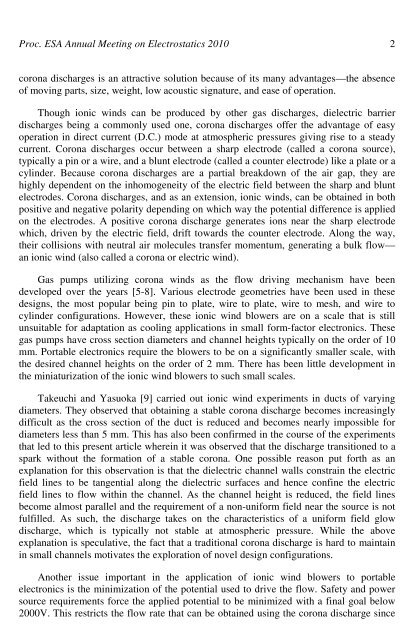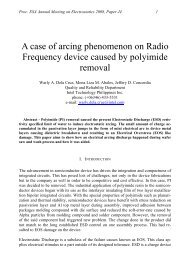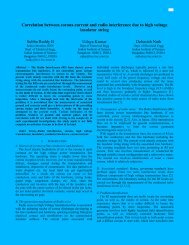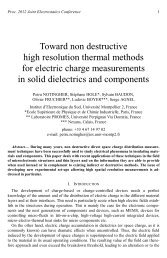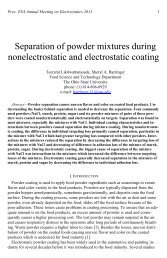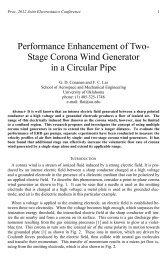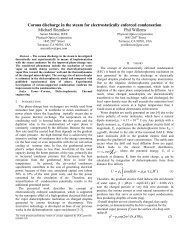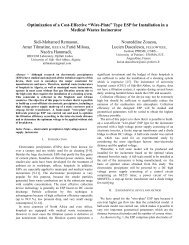The Assisted Corona Discharge: Multi- Electrode Configurations and ...
The Assisted Corona Discharge: Multi- Electrode Configurations and ...
The Assisted Corona Discharge: Multi- Electrode Configurations and ...
Create successful ePaper yourself
Turn your PDF publications into a flip-book with our unique Google optimized e-Paper software.
Proc. ESA Annual Meeting on Electrostatics 2010 2<br />
corona discharges is an attractive solution because of its many advantages—the absence<br />
of moving parts, size, weight, low acoustic signature, <strong>and</strong> ease of operation.<br />
Though ionic winds can be produced by other gas discharges, dielectric barrier<br />
discharges being a commonly used one, corona discharges offer the advantage of easy<br />
operation in direct current (D.C.) mode at atmospheric pressures giving rise to a steady<br />
current. <strong>Corona</strong> discharges occur between a sharp electrode (called a corona source),<br />
typically a pin or a wire, <strong>and</strong> a blunt electrode (called a counter electrode) like a plate or a<br />
cylinder. Because corona discharges are a partial breakdown of the air gap, they are<br />
highly dependent on the inhomogeneity of the electric field between the sharp <strong>and</strong> blunt<br />
electrodes. <strong>Corona</strong> discharges, <strong>and</strong> as an extension, ionic winds, can be obtained in both<br />
positive <strong>and</strong> negative polarity depending on which way the potential difference is applied<br />
on the electrodes. A positive corona discharge generates ions near the sharp electrode<br />
which, driven by the electric field, drift towards the counter electrode. Along the way,<br />
their collisions with neutral air molecules transfer momentum, generating a bulk flow—<br />
an ionic wind (also called a corona or electric wind).<br />
Gas pumps utilizing corona winds as the flow driving mechanism have been<br />
developed over the years [5-8]. Various electrode geometries have been used in these<br />
designs, the most popular being pin to plate, wire to plate, wire to mesh, <strong>and</strong> wire to<br />
cylinder configurations. However, these ionic wind blowers are on a scale that is still<br />
unsuitable for adaptation as cooling applications in small form-factor electronics. <strong>The</strong>se<br />
gas pumps have cross section diameters <strong>and</strong> channel heights typically on the order of 10<br />
mm. Portable electronics require the blowers to be on a significantly smaller scale, with<br />
the desired channel heights on the order of 2 mm. <strong>The</strong>re has been little development in<br />
the miniaturization of the ionic wind blowers to such small scales.<br />
Takeuchi <strong>and</strong> Yasuoka [9] carried out ionic wind experiments in ducts of varying<br />
diameters. <strong>The</strong>y observed that obtaining a stable corona discharge becomes increasingly<br />
difficult as the cross section of the duct is reduced <strong>and</strong> becomes nearly impossible for<br />
diameters less than 5 mm. This has also been confirmed in the course of the experiments<br />
that led to this present article wherein it was observed that the discharge transitioned to a<br />
spark without the formation of a stable corona. One possible reason put forth as an<br />
explanation for this observation is that the dielectric channel walls constrain the electric<br />
field lines to be tangential along the dielectric surfaces <strong>and</strong> hence confine the electric<br />
field lines to flow within the channel. As the channel height is reduced, the field lines<br />
become almost parallel <strong>and</strong> the requirement of a non-uniform field near the source is not<br />
fulfilled. As such, the discharge takes on the characteristics of a uniform field glow<br />
discharge, which is typically not stable at atmospheric pressure. While the above<br />
explanation is speculative, the fact that a traditional corona discharge is hard to maintain<br />
in small channels motivates the exploration of novel design configurations.<br />
Another issue important in the application of ionic wind blowers to portable<br />
electronics is the minimization of the potential used to drive the flow. Safety <strong>and</strong> power<br />
source requirements force the applied potential to be minimized with a final goal below<br />
2000V. This restricts the flow rate that can be obtained using the corona discharge since


